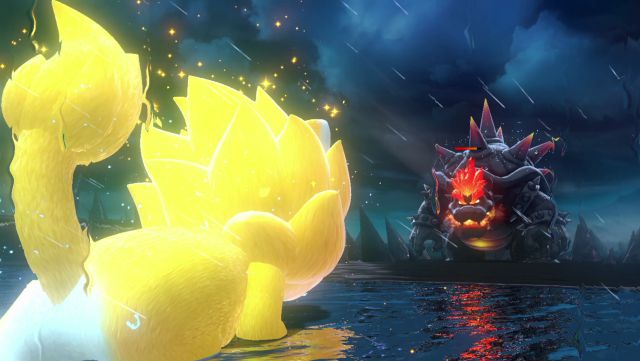
The Wii U platforms returns with online and an unprecedented expansion. We remember how it was created and we anticipate impressions after several hours of play.
Here we are again, preparing to review a game that has already been reviewed, but still has a lot to say. Released in 2013 on Wii U, the original version of Super Mario 3D World was the first —and at the moment also unique— incursion of the 3D side of the saga in a full-fledged multiplayer. Both the Mario Galaxy on Wii and the recent Mario Odyssey incorporated cooperative through a secondary character who assisted the main character with simple actions, but 3D World allowed up to four players to handle Mario, Luigi, Peach and Toad simultaneously, all of them with minor differences in handling. Naturally, achieving this required a thorough rethinking of the design and the gameplay, and that is precisely what we will talk about in the preamble of the Reviews, although not for that reason stopping to advance impressions after several hours with the new version.
In the video at the top of this text, you can take a look at five minutes of solo play, going through a selection of levels from the first half of the game; another five minutes of online multiplayer games, release mode on Switch; and finally, also five minutes of Bowser’s Fury, a new expansion that takes the mechanics of the main game to an open environment, designed for a player, thus bridging the direct gameplay of 3D World and that of more adventurous deliveries such as Super Mario 64 or the already mentioned Odyssey. We will expand on these and other news at the end, so you can skip to the last section if you want to dig a little deeper into them. Before that, we have to take a brief trip through the past of the plumber to explain how and why Super Mario 3D World works.
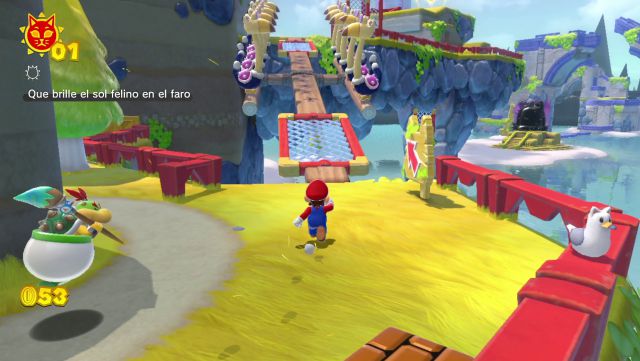
Platform syntax
Have you played any of the Bayonetta? Also relaunched on Switch years ago, both hack and slash use the loading screens between levels to drop the protagonist witch into a void where the player can practice the available combos. In this scenario there are no enemies or obstacles, Bayonetta hits the air, but we can successfully activate techniques created to participate in it. These techniques are part of the repertoire of basic mechanics, the series of actions (hitting, dodging, jumping) that the player can execute in any context, but they need other elements to form what we commonly define as “playability”. Challenges that require increasing dexterity in the deployment of these actions and also events that create new contexts to enable others (for example, activating the witch time that slows down enemies if we dodge just before receiving an attack).
Using Bayonetta and its mechanics in a vacuum as a starting point clearly illustrates this kind of “syntax” implicit in video games. Each genre or even individual work is like a language with specific rules, nouns and verbs that serve for the player to communicate with the game and achieve better results as they become fluent in them. Mario’s, of course, is not a combat-oriented language as it is movement-oriented, to overcoming the obstacles posed by the levels, although dealing with enemies has been an essential component from the beginning, be it avoiding them, stepping on them or using power -ups that expand the repertoire of mechanics / verbs available to the player.
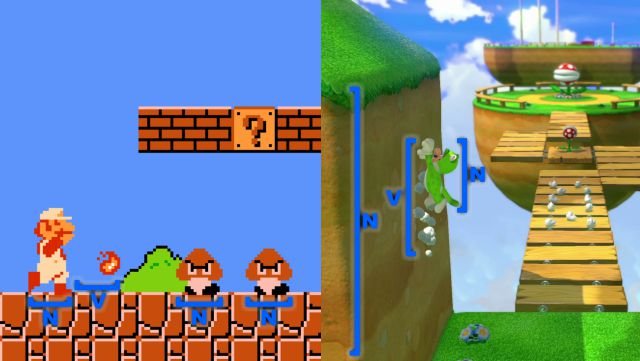
From the flower that lets you launch fireballs in Super Mario Bros. to the rattle that grants cat agility in 3D World – through raccoon tails, frog suits, Yoshi and a long list of others – these kinds of removable mechanics They have played a key role both in ensuring that each installment had its own identity and in keeping a base repertoire interesting as simple as possible. Thus they provide a friendly entry point for any type of player, who already from the first level understands and begins to gain ease with all the actions necessary to complete the game, without alienating the most skilled because the design is in charge of supplementing it. with a variety of obstacles and enemies, increasing difficulty and hand experimentation with power-ups that can be taken to levels where the developers did not include them by default.
Three dimensions, more complications
It’s one of the factors that have helped keep the series among the most popular for decades, but also one that favors 2D versus 3D deliveries when we stop to look at their sales. Almost 25 years after its premiere, Super Mario 64 remains one of the most revolutionary and influential games in the medium, but it is a fact recognized by Nintendo itself that neither then, nor in subsequent installments such as the Galaxy, all fans have accompanied the plumber in his jump to the third dimension. It is the consequence, as we say, of several factors, ranging from the need to live with a camera that in horizontal scroll games blends with the action in a more natural way to the open – sometimes cryptic – nature of lenses that are no longer visible. limited to reaching the end of a level. And that also include, of course, a more elaborate control system.
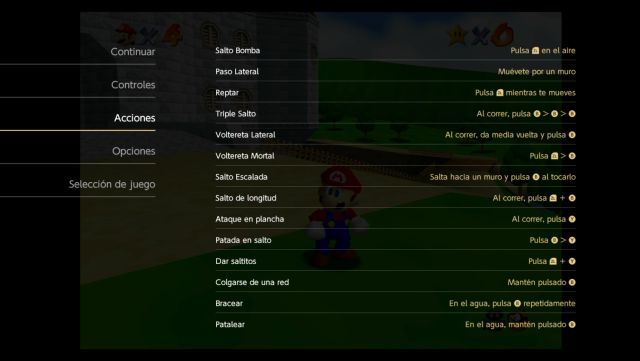
In its reformulation of the platform, Super Mario 64 gave less priority to power-ups and more to the base repertoire, considerably expanded and with many optional actions or partially overlapping each other (different types of jump were activated in different conditions) to enhance the facet expressive of movement. Returning to the analogy of language, his lexicon allowed for more flourishes, such as writing poetry instead of sticking to the efficiency of prose, but for many that translated into a somewhat higher barrier to entry. The irony of games like Mario 64 or its immediate successor, Mario Sunshine, is that, although the vast majority of those who read this text will surely agree that they are “easier” than the NES installments (they require less precision and allow more errors to finish them), they also intimidate a significant percentage of the public more when it comes to starting.
In order to remedy this, Nintendo reduced both the base repertoire and the scale of the levels in Mario Galaxy and its sequel, games of more measured design, often automated cameras and again populated by power-ups like flowers of fire and ice, costumes for bee, boo, cloud, dock, etc. An approach to the 2D philosophy that soon after reached an almost perfect middle ground with Super Mario 3D Land: the delivery of 3DS sported a 3D in the title that alluded to the stereoscopic effect of the notebook, but it further concentrated the scale, pre-programmed each and every camera angle, allowed to carry power-ups between levels and adapted an infinity of classic ideas – and some new ones – to a development marked by brief and linear phases with a flag at the end. In Nintendo’s own words, it was “the missing link,” the intersection between Mario Galaxy and New Super Mario Bros. that left no one out.
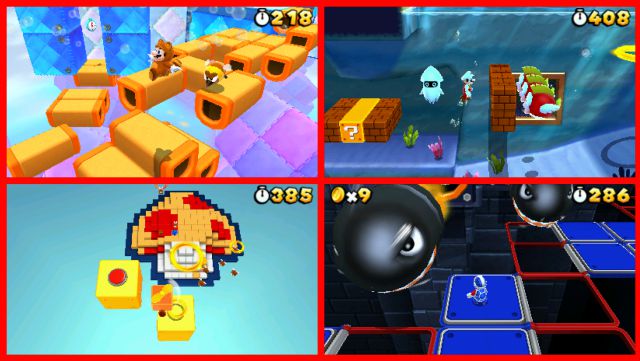
From Land to World: Four Times Fun
3D Land was a game tailor-made for 3DS, an exercise in design efficiency that ranged from the aforementioned use of the stereoscopic effect to better calculate the distance of platforms to the ability to function perfectly without an analog second — than other games. they did miss— or the economy of resources that allowed to produce a high amount of content (8 main worlds plus 8 extra with more difficult levels) without going beyond the more humble production values that handled the portable deliveries. However, that was not the end of this particular series, because the study soon saw that the new formula put on a platter to settle a pending account from Super Mario 64: multiplayer.
With Wii U, the 3D effect was lost, but a superior computational capacity was gained to manage the actions of four simultaneous players at broader levels and with greater detail. Another key factor was the console’s compatibility with various types of controllers, including the millions of Wiimotes that its predecessor had placed on the market. In its mission to get closer to the audience of 2D deliveries, 3D Land had returned to the use of a button to run (instead of simply scrolling the analog) and applied an octagonal correction system to the addresses, something that 3D World was worth. to fit like a glove on the control cross that many players would use in multiplayer. In return, he also reintroduced some base actions not present in 3D Land or Galaxy (such as Sunshine’s spin jump), but his focus was once again on the power-ups and specific mechanics of each level, more numerous and varied than in 3DS.

Arrival at Switch and Bowser’s Fury
As you will surely know if you have followed the news, Super Mario 3D World + Bowser’s Fury will be released on Switch on February 12, thus becoming the fifth Mario platformer on the console after Odyssey, Maker 2, NSMBU DX and the recent compilation 3D All- Stars. It is true that by now the Nintendo hybrid is very well-stocked and has covered almost every possible facet: the most open platform adventure in Odyssey, the level editor in Maker 2, the multiplayer in NSMBU DX and even the adaptation of Captain Toad: Treasure Track, a puzzle spin-off that originated precisely in 3D World. But that does not detract from the appeal of the relaunch because, as we said at the beginning, it still remains the only Mario 3D with multiplayer, and because it also now returns with online.
In the test games that we have been able to play, the lag has made an occasional appearance, but the general calculation has been positive and is emerging as an offer as crazy as that of other games from the Nintendo factory (it has not shown the same stability as Mario Kart 8 Deluxe, but we have not experienced stops as frequent or serious as those that could weigh down Super Smash Bros. Ultimate at its worst). On the other hand, Captain Toad’s minigames also benefit from multiplayer to four (both local and online), and the game makes some adjustments in general mobility, more agile thanks to an increase in speed, a greater length in jumps and cat climbing or incorporating a forward throw between base techniques. On the other hand, it also adds a photo mode that allows us to use the stamps that we find hidden by the levels, once dedicated to the Miiverse service and now colored for the new function.
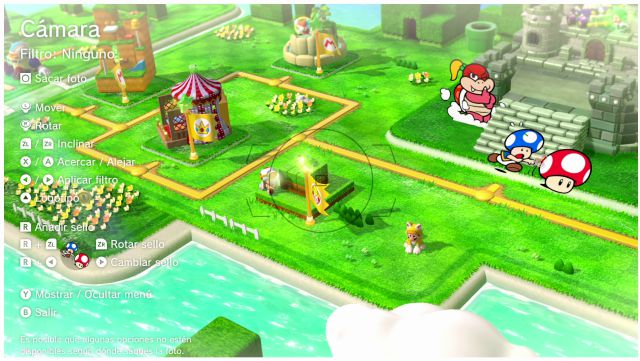
The notebook performance, as you might expect, is also solid on both the sharpness and performance side. Although years after its initial release it still looks great thanks to inspired art direction, the game hardly rivals Odyssey on a technical level, but it’s nice to see that nothing has gone awry in the conversion. Something more demanding is Bowser’s Fury, which does present specific slowdowns both in portable and dock mode. The engine was conceived for other types of levels, so completely freeing the camera and distributing the tests over a large archipelago requires an extra effort (also evidence of popping in the loading of distant elements), but it is a minor detail , little intrusive, that does not cloud the praiseworthy work of the study adding new content to the game.
If anything, Bowser’s Fury will soon be revealed as one of the main attractions of this edition, surely the most for those who play their Marios alone. The expansion, in fact, omits the multiplayer to four (although not the asymmetric cooperative thanks to Bowsy), something that has a significant impact on both the level design, now oriented to search and collect suns (quite in line with the moons of Mario Odyssey), as in the control, which remains anchored in the change of speed by pressing a button, but increases the number of skillful directions to get more out of the analog stick. It is, perhaps, another camouflaged attempt by Nintendo to bring audiences closer together, this time dedicated to gently pushing 3D Land / World fans towards the terrain of the most open platforms.
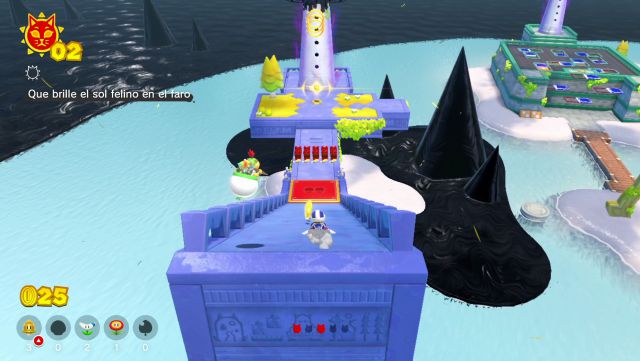
Coming from 3D World, accommodation is fast thanks to the use of power-ups (cat bell, tanuki leaf, boomerang flower …), enemies and obstacles already seen in the main game, but distributed with the reinvigorated creativity that allows the new structure. Bowser’s Fury has no countdowns or goal flags, and allows you to store up to five power-ups of each type to change at any time, so the experience is more flexible and relaxed. Or well, at least it is until Bowser appears and justifies the choice of the title: covered in ink and turned into a gigantic angry mass, Mario’s archenemy bursts in from time to time and attacks us spitting large fire projectiles.
A nuisance, but also an opportunity to find new suns thanks to the damage it causes in some parts of the stage and the temporary platforms into which other projectiles in the form of spines are converted. In addition, getting suns is used to unlock a large golden bell that, as you may already know if you have seen the trailers, allows Mario to catch up with it. On whether that’s enough to stop Bowser, and what the expansion holds beyond that initial encounter, we’ll talk about the Reviews coming. But we already anticipate that there are reasons to be interested, even by those who already have the Wii U version.
